LE GRUYÈRE AOP: PRIDE OF PLACE
A comprehensive guide to selling Switzerland’s mighty mountain cheese
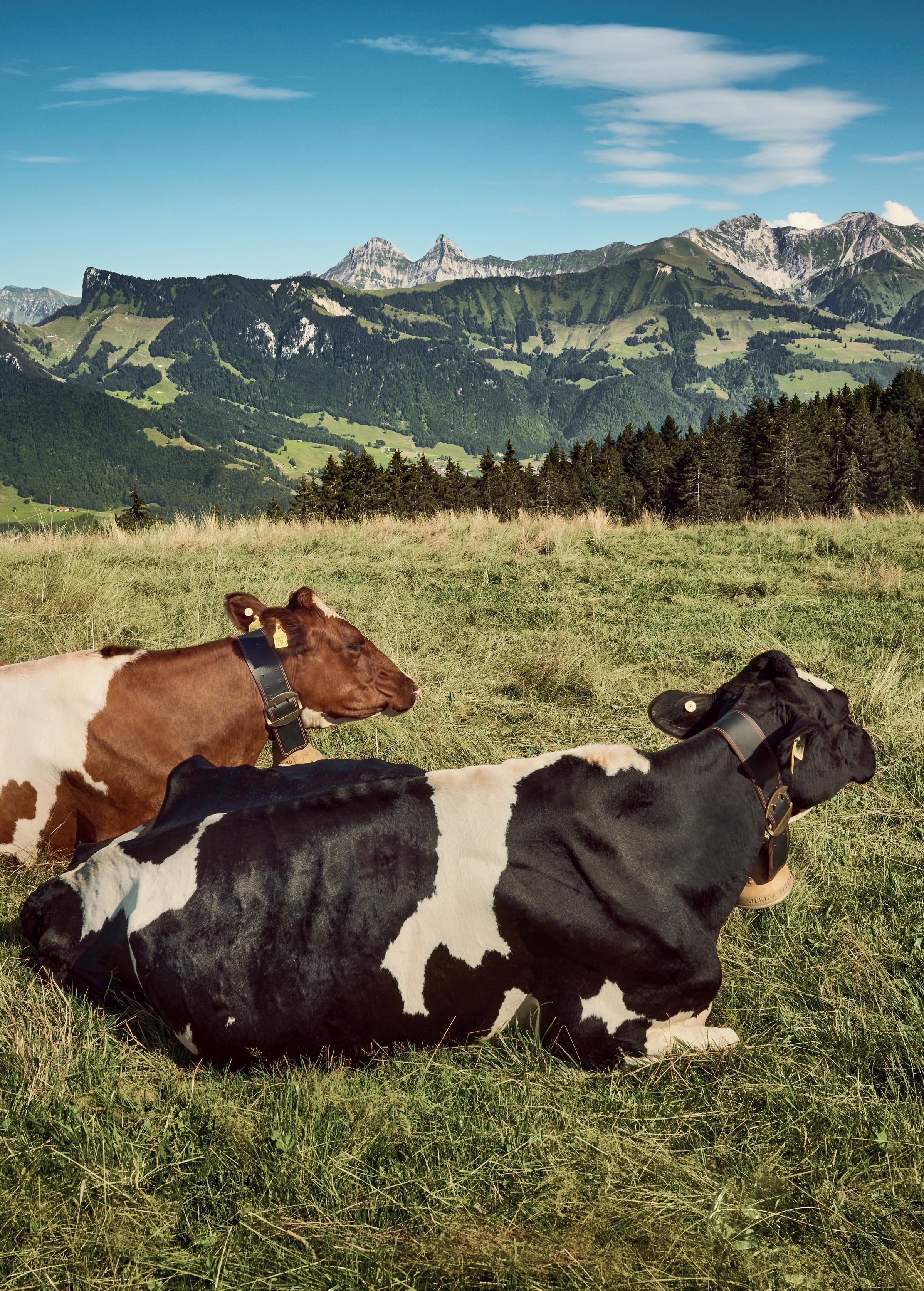
Updated edition, featuring the World Cheese Awards champion
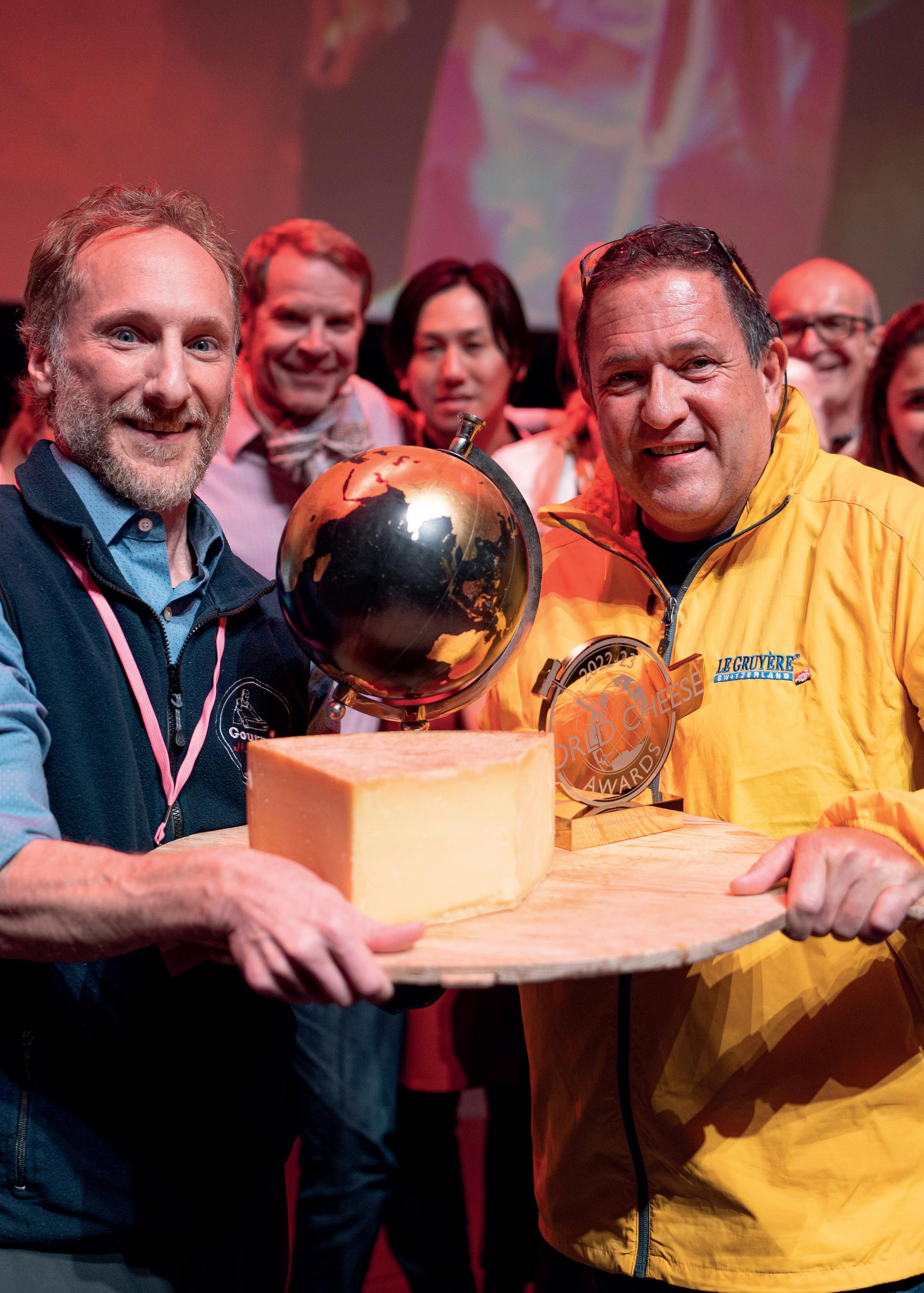
Le Gruyère AOP is a big cheese in more ways than one. Made in 35kg wheels that require strong arms for lifting, the cheese is famous across the world where it is sold everywhere from small fromageries to big supermarkets. But in other ways, Le Gruyère AOP is still small in scale, made with milk from tiny farms in village dairies, not factories.
To truly understand both sides of the famous cheese, requires a proper appreciation of the terroir, history and way of life in the Alps in Western Switzerland where it is made. Under the terms of it Appellation d’Origine Protégée (AOP), which protects where and how it is produced, Le Gruyère AOP can only be made in Switzerland in the cantons of Fribourg Vaud, Neuchâtel, and Jura, and a few municipalities of Bern.
This Alpine region is home to more than 1,800 farms, who deliver milk to their local village dairies twice a day. On average each dairy farmer has just 30-50 cows – a tiny number by modern standards. These family farms are at

DID YOU KNOW?
It takes 400 litres of milk to make a 35kg wheel of Le Gruyère AOP
the heart of what makes the cheese so special, acting as custodians of the land and guardians of quality and tradition. By law, milk for Le Gruyère AOP can only come from cows fed on grass in the summer and hay in the winter – the vast majority of which is grown in the region. That means strictly no additives or silage (fermented grass).
The region’s valleys, hills and mountains echo with the gentle ring of
A SENSE OF PLACE
Le Gruyère is legally protected by an Appellation d’Origine Protégée (AOP), similar to the EU’s PDO status. This means:
• The cheese can only be made in the cantons of Fribourg, Vaud, Neuchâtel and Jura in Switzerland, and a few municipalities of Bern
• Le Gruyère AOP must be made with raw milk
• Additives, GMOs and preservatives are strictly forbidden
• 70% of the cows’ forage must come from the farm
• Silage is forbidden
• Milk must be used within 18 hours after milking
cow bells as the animals graze diverse pastures. The milk for Le Gruyère AOP typically comes from Red Holstein and Holstein cows, but also Montbéliardes, Brown Swiss and Simmentals. Each animal produces about 30kg of milk per day, munching their way through 20kg of natural forage (grass or hay), plus natural proteins, with at least 70% of the cows’ diet coming from the dairy farm.
It takes around 400 litres of fresh milk to produce one 35 kg wheel of cheese, with the animals milked morning and night. After each milking, the farmer delivers directly to the local dairy, which by law must be located within a 20km journey from the farm. Crucially only raw milk is permitted so that the full flavour of the pasture and the unique microflora of the farms and dairies themselves is fully expressed in the final cheese.
Like the farms that supply them, the dairies themselves are typically small family affairs, which work with just a handful of local farms. There are more than 160 Le Gruyère AOP cheese dairies, run by craftsmen (and it is mainly men), who must complete four years of schooling to become ‘cheese masters’. They often work seven days a week, often side-by-side with their wives, starting at 5am and finishing around lunchtime, before caring for their cheeses in the cellar and taking in the evening milk at around 7pm. It means long days and hard work, but this is how it has always been done.
The taste of terroir
It might be a familiar sight in shops around the globe, but Le Gruyère AOP is still firmly rooted in the place where it has always been made
2
LE GRUYÈRE: PRIDE OF PLACE
900 YEARS IN THE MAKING
To really know Le Gruyère AOP requires a quick history lesson. Records show that the cheese was made around the small town of Gruyères in the Canton of Fribourg in 1115. Medieval chronicles reference the expertise of the local cheesemakers, who turned milk into a full-fat cheese that was even exported to France and Italy. The cross-border popularity of the cheese continued into the 17th century, when the name Gruyère was first recognised officially in 1602 as exports boomed. As people emigrated from the Fribourg to other parts of Switzerland and the cheese became more popular, the geographical production zone spread to the cantons
DID YOU KNOW?
of Vaud, Neuchâtel and Jura, as well as to neighbouring France. The cheese was increasingly imitated in other areas and a campaign to gain protection for the name Gruyère began to build momentum in the 19th century. Negotiations were held in Madrid (1891) and Paris (1926) to get legal recognition, before a meeting in Rome in 1930 led to the signing of a first agreement to protect the denominations of goods and their origin. However, it was only in 2001 that Gruyère cheese was granted Appellation d’Origine Contrôlée (AOC) at a national level and then full AOP status for all of Europe in 2011.
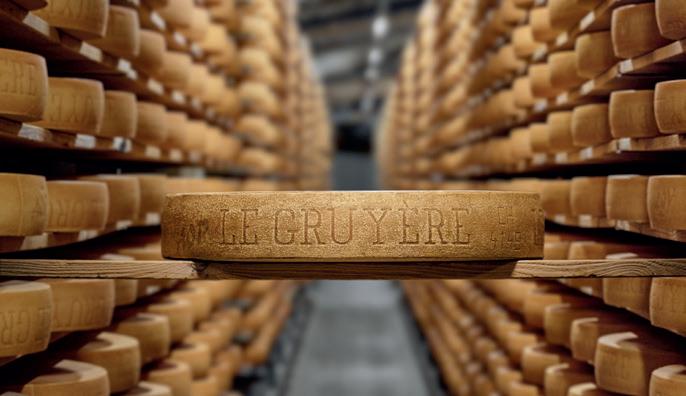
WELCOME TO THE WORLD OF LE GRUYÈRE AOP
If you ever get the opportunity to visit Switzerland to see Le Gruyère AOP being made, then you should jump at the chance. By spending time at the small farms, village dairies and specialist affineurs that devote their lives to the cheese it soon becomes clear what makes it so special.
Le Gruyère AOP is a global brand, but this is only possible through the solidarity and hard work of thousands of small businesses in the Swiss mountains that come together to create something that is bigger than the sum of their parts.

This supplement aims to tell the story of this collective spirit, which is rooted in the landscape, history and culture of Switzerland, and is expressed in cheeses that are full of flavour.
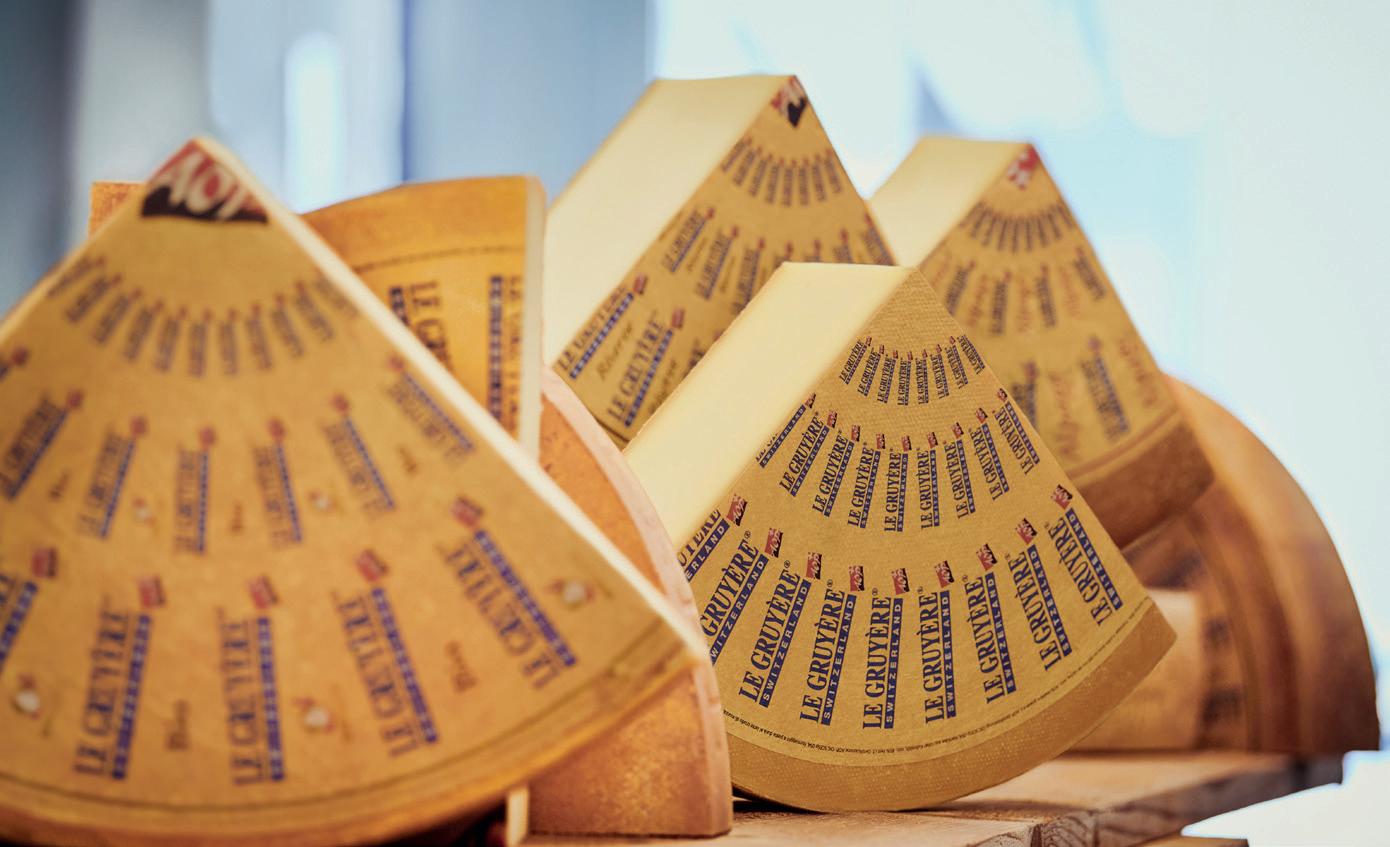
Britain’s delis, farm shops, food halls and cheese shops will undoubtedly know and love Le Gruyère AOP, but there’s always more to learn. From the strict rules that govern its production and the various styles to how to taste the cheese professionally and what to pair it with, we aim to give you the full picture.
There are only around 50 chalets spread around the mountains of Fribourg, Vaud and Bernese Jura that make Le Gruyère d’Alpage AOP
terroir
EDITORIAL Editor: Patrick McGuigan
Art director: Mark Windsor
ADVERTISING advertise@gff.co.uk
Sales director: Sally Coley
GENERAL ENQUIRIES
Tel: +44 (0)1747 825200 info@gff.co.uk www.gff.co.uk
Guild of Fine Food, Guild House, 23b Kingsmead Business Park, Gillingham, Dorset sp8 5fb uk
PUBLISHED BY The Guild of Fine Food © The Guild of Fine Food Ltd 2023
Reproduction of whole or part of this magazine without the publisher’s prior permission is prohibited. The opinions expressed in articles and advertisements are not necessarily those of the editor or publisher.
Managing director: John Farrand
PRINTED BY Blackmore, Dorset
of
3
LE GRUYÈRE: PRIDE OF PLACE
The
The making of a masterpiece
It’s a ritual that has taken place every morning for hundreds of years and is still going strong today. As the sun rises over the mountains, farmers deliver fresh milk to dairies across the Swiss alps, where it is gratefully received by the cheesemaker.

It marks the beginning of a magical process of alchemy that sees liquid raw milk turned into hard cheese that can be aged for a year or more. The morning milk is mixed with evening milk, which has been left to settle overnight, in a copper vat. The vat is
important – only copper can be used under the terms of Le Gruyère’s AOP, partly because it has long been the tradition, but also because it distributes heat more evenly and contributes to the cheese’s unique flavour and texture.
The milk is left raw and unpasteurised, so that the unique microflora and flavours are not damaged. Likewise natural starter cultures made from whey are used to kick-start the cheesemaking process, ensuring a diverse family of lactic acid bacteria are introduced to the milk
NATURALLY LACTOSE-FREE
Shoppers who are intolerant to lactose often believe they can’t eat cheese, but a well informed cheesemonger knows better.
Le Gruyère AOP is naturally free of lactose because the sugar in the milk is fermented into lactic acid during the production process and the long maturation period. The cheese is also glutenfree and contains no GMOs.
This is good news for concerned consumers and for cheesemongers, who can tap into growing demand for free-from foods. According to research, the global market for lactose-free cheeses is growing at 8% a year and is due to more than double in the next decade. More importantly, if you can explain to a lactose-intolerant customer that it safe for them to eat Le Gruyère AOP, they will love you forever.
rather than the limited range found in the lab-grown frozen bacteria used by many industrial producers.
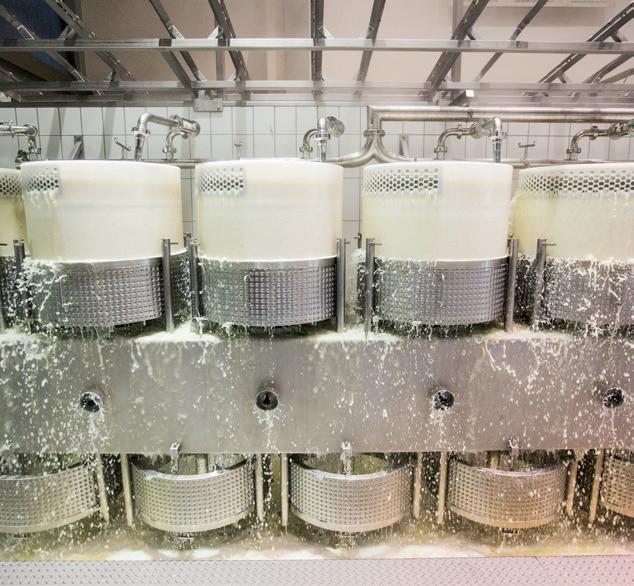
Once the milk has matured, traditional rennet is added to create a dense curd in the vat. It’s a remarkable thing to see liquid become solid thanks to a natural enzyme extracted from the stomach of a calf.
At this point, cheesemaking starts to gather pace in the warm, steamy dairy. The curd is cut into tiny pieces the size of grains of wheat with knives known as cheese harps (‘tranche-caillé). This
DID YOU KNOW?
At four months, the wheels of cheese are checked and taxed by experts of the Interprofession du Gruyère association, according to very precise and rigorous quality criteria. They can display the name Le Gruyère AOP only after this taxation.
alchemy of turning raw milk into Le Gruyère AOP is a proud tradition that has been passed down through the generations
4
LE GRUYÈRE: PRIDE OF PLACE
THE FOUR FACES OF LE GRUYÈRE AOP
Le Gruyère AOP
Aged for six to nine months, the Classic cheese has a soft pliable texture and a delicate aroma. The flavour is pleasant and sweet with sweet milk and butter notes, plus hints of hazelnuts and a gentle savoury finish.
Le Gruyère AOP Réserve
An older cheese that is matured for at least 10 months, but often much longer, Le Gruyère AOP Réserve is a much more intense experience. The texture becomes increasingly firm and crumbly as it ages with a full-bodied, fruity flavour that often takes in savoury notes (especially near the rind).
Le Gruyère AOP Bio
DID YOU KNOW?
Only open copper vats with a maximum capacity of 6,600 litres can be used to make Le Gruyère AOP.
helps separate the curd from whey, a process that is encouraged by heating and stirring the curd at 57°C (135°F) for 40-45 minutes. The cheesemaker carefully checks the curd by hand kneading the small grains together to check the texture and when completely satisfied pumps the contents of the vat (curds and whey) into round moulds, where the whey rapidly drains away.
Each mould is marked on its outer edge (the ‘heel’) with the inscription ‘Le Gruyère AOP’. A marking made with casein (a natural protein found in milk) is made on the curd, indicating the number of the cheese wheel and of the cheese dairy, plus the manufacturing date. It is then pressed for about twenty hours, with an applied force of up to 900kg to help further squeeze whey from the curd and create a smooth paste, before each wheel is brined for 24 hours.

In many ways this is only the start of the journey for Le Gruyère AOP. The maturation process is as much a part of the cheese’s production process as the initial make. Traditionally, cheesemakers look after their young wheels, which weigh between 2540kg, in their cellars for around three
months, before they are passed on to specialist cheese maturers, known as an ‘affineurs’. There are 11 affineurs in the production region, who carefully ripen the cheeses to perfection in ‘caves d’affinage’ - maturing cellars that are kept a constant 90% humidity and 1218°C (59°F) temperature. The wheels are also turned and brushed with brine to create a golden, orange rind with a wonderful rich aroma.
How long affinage lasts is up to the cellar masters, who have decades of experience in developing cheeses to their full potential and use all their senses to assess the cheeses, taking samples with their cheese irons to inspect the appearance, texture, aroma and taste. They even tap the wheels to listen for any cracks or other defaults. Some cheeses will be ready at five months. Others will reach their full potential and 18 or even 24 months.
There are so many factors that can influence the final cheese. From the weather and the geographical location of the farm and the dairy to the knowhow of the cheese-maker and the refiner, each cheese follows a slightly different path as it develops its own unique character.
Made from organic milk produced according to the standards set by BioSuisse, the cheese is similar in style to the Classic and Réserve, starting out with a gentle refined flavour at six to nine months, before becoming more intense at 10 months and above.
Le Gruyère d’Alpage AOP
A seasonal cheese that is made between mid-May and mid-October high up on mountain pastures, where the cows graze a remarkably diverse array of herbs, flowers and wild grasses.
The raw milk is turned into 25kg wheels in small chalets, where cheesemakers work with copper cauldrons hung over open wood fires. Read more about the production of Alpage cheese on page 6.
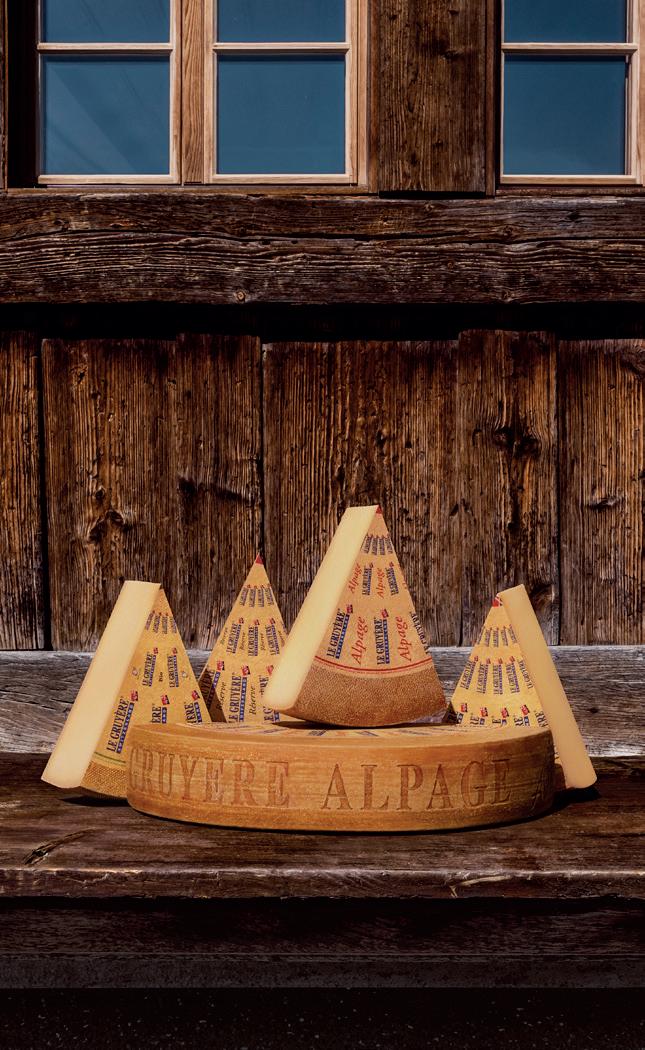
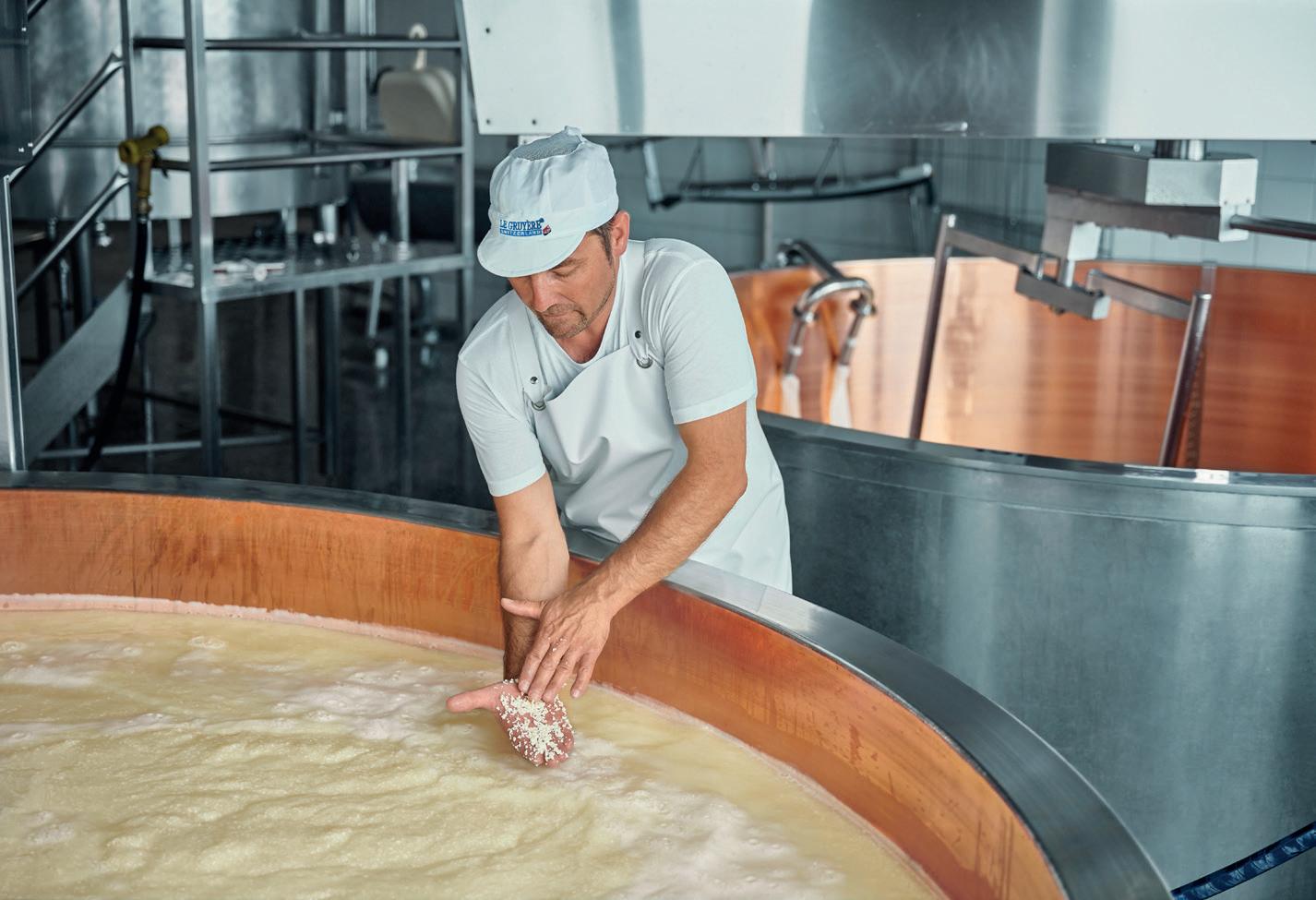
LE
PRIDE OF PLACE 5
GRUYÈRE:
High society
There’s no mistaking when autumn has arrived in the Swiss Alps. In September and October, villages in the foothills of the mountains reverberate with the sound of yodelling, horns, cow bells and the clatter of hooves as herds of cows are brought down from their high summer pastures. The ‘désalpe’, as it is known, is a much-loved celebration with plenty of singing, dancing and feasting in honour of the returning cheesemakers and their cows, whose horns are garlanded with flowers.
It’s an ancient tradition to mark the passing of the seasons and the return of families, who have spent the summer months high up in the mountains making a special type of cheese. Le Gruyère d’Alpage AOP is only made between mid-May and mid-October, when the cows are taken up into the mountains to graze lush pastures made up of Alpine flowers, herbs and wild grasses. Their raw milk is used to make just a handful of wheels of cheese each day in tiny mountain chalets, where cheesemaking techniques haven’t changed for centuries.
Copper cauldrons hung over open log fires are used to heat the curd, which is gathered and lifted from the vat by hand using large linen cloths. The cloths filled with curd are then placed in moulds and pressed into smaller wheels that finish up weighing around 25kg. Every cheese

made in this way must be clearly labelled with the words ‘Le Gruyère d’Alpage AOP’ imprinted on the side of the wheel.
Each stage of the process is closely governed by strict rules set out in the AOP, which specify requirements, such as the use of home-made whey starter cultures and a diet of permanent grass from summer pastures for the cows. The milk must come from the place where the cheese is made or from a neighbouring summer pasture, no more than 10 km away,
Only around 50 chalets, spread over the cantons of Fribourg, Vaud and Bernese Jura, make Le Gruyère d’Alpage AOP, accounting for around 580 tonnes of cheese in 2021 – a tiny part of total Le Gruyère production, which stood at 33,000 tonnes in the same year.
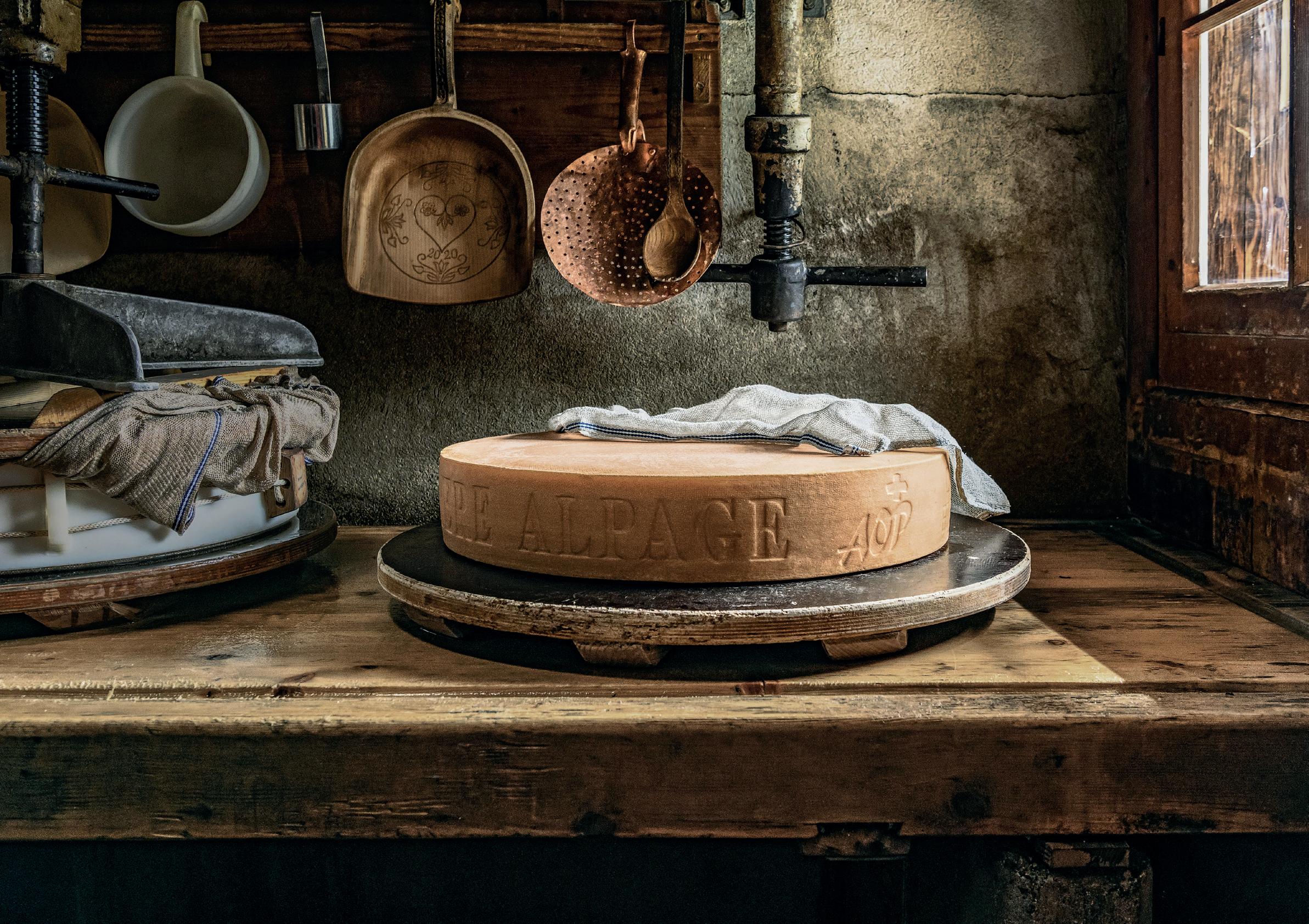
Each chalet has its own unique terroir linked to altitude, aspect, flora and the know-how of the individual cheesemaker.
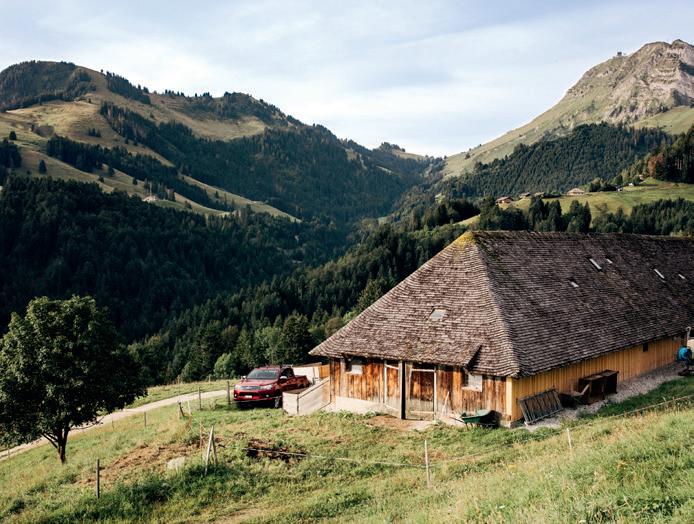
is celebrated in style
DID YOU KNOW?
Around a thousand tonnes of Le Gruyère AOP was exported to the UK in 2021
This is reflected in the final cheeses, which demonstrate a wide range of flavours and textures, depending on when, where and how it was made.
It’s estimated that there are over 100 different plant species in Alpine pastures, compared to fewer than two dozen in lower lands. What’s more, the composition of the meadows changes throughout the summer with different flowers and herbs in different months. Families will also sometimes own more than one chalet, moving themselves and their cows to different pastures at different points in the season.
This adds to the variability of the cheese. Typically aged for 10 to 18 months, the flavour and textures can change from batch to batch and producer to producer, but powerful fruity and floral notes are common, plus savoury depths and even the occasional smoky note from the wood fires.
No wonder there is such a big party when the cows and the cheesemakers make their descent at the end of the summer.
LE GRUYÈRE: PRIDE OF PLACE
The ancient tradition of taking herds high up to graze mountain pastures in the summer is alive and well in the Alps, where Le Gruyère d’Alpage AOP
6
Meet your match
The complex flavours and different age profiles of Le Gruyère AOP make it a versatile cheese for matching with all sorts of drinks from wine, beer and cider to fortifieds, whisky and even tea. Here are six of best of the best to try.

WINE
The caramel, fruity notes of a Le Gruyère AOP Classic are well suited to aromatic white wines, especially off-dry Rieslings from Germany or Alsace. Young wines typically have zesty, appley notes, plus nice acidity to cut through the creaminess of the cheese. For older cheeses, red wines are recommended from the perfumed, red berry notes of Pinot Noir to more fullbodied styles for aged cheeses, such as rich and expressive Amarone from Italy.
FORTIFIED WINE
Le Gruyère AOP
Réserve at over a year old develops savoury, salty depths that can stand up to more powerful wines. Red Vermouth, which is popular in Italy, is an great match. The fortified wine, which is flavoured with botanicals, has a spicy, herbal and pleasantly bitter edge, which tease out floral, herbaceous notes in the cheese. Fortified wines are a good choice in general for mature cheeses – Oloroso sherry, tawny Port and Madeira are all good options.
WHISKY
The richness and complexity of mature Gruyère, especially Le Gruyère d’Alpage AOP, means it can also find harmony with certain whiskies. The fruity, spicy, vanilla notes of a Kentucky Rye are a particularly interesting match, dovetailing with many of the flavours in the cheese.
BEER
There is much fun to be had trying different styles of Le Gruyère AOP with different beers. Classic cheeses work well with fruity, flowery amber ales and also sweet Bock lagers from Germany. Typically, stronger beers work best with Réserve cheeses. Think Belgian golden ales or Dubbels and Tripels.
DID YOU KNOW?
Did you know? Gruyère must be matured for at least five months, before it can be sold
TEA
L’Interprofession du Gruyère in Switzerland has carried out new research into matching tea and Gruyère with fascinating results. The tannins and complex flavours in tea are a good foil for the cheese in a similar way to wine. Some of the best pairings include Le Gruyère AOP Réserve 15 months with a smoked tea from the Lapsang Souchong family and Le Gruyère d’Alpage AOP 12 months with a Japanese green tea.
CIDER
There are a huge range of different styles of cider, from dry and flinty to sweet and velvety. The tannins work in a similar way to those of wine when paired with Le Gruyère AOP. Try a bone-dry cider with Le Gruyère AOP Classic –light, sparkling and refreshing it works a little like Champagne with the young creamy cheese. For more mature cheeses, medium and even medium-sweet ciders with notes of toffee apple and plums are a lovely option, contrasting with the salty, savoury cheese.
LE GRUYÈRE: PRIDE OF PLACE 7
How to taste Le Gruyère AOP
A step-by-step guide to getting the most from your cheese
MOULDYSOAPRANCIDACETICAMMONIASULPHUROUS
TASTE
Slowly chew the cheese to let the complex flavours fully express themselves and try to pinpoint flavours on the aroma wheel (opposite) as you do so.
VANILLICCARAMELICTOASTEDTOASTEDSEEDSBURNT
LOOK
While it’s tempting to tuck straight into a delicious piece of Le Gruyère AOP, it’s better to take your time and fully appreciate the experience. A visual inspection of the cheese is a good starting point. Classic cheeses, aged for six to nine months, have lighter rinds and a paler paste, compared to Réserve cheeses, which will become progressively darker and more golden. You may also spot some crystals in mature cheeses. These are amino acids called tyrosine, which form as the protein structure breaks down during maturation. They add a lovely crunch to the cheese.
TOUCH
Give the cheese a squeeze – texture is important. A young Le Gruyère AOP has a dense, pliable structure, which is almost fudgey to the touch. Mature cheeses become much harder and crumbly with more snap and brittleness.
PEALEDCHESTNUTWALNUTHAZELNUTVIOLETROSE
SMELL
Time will tell with Le Gruyère AOP, so while Classic cheeses have gentle milky aromas with delicate hints of fresh hazelnuts, pasture or hay, the Réserve cheeses often have a much stronger scent. Think caramel and roasted nuts, but also fruit notes. The rind in particular could be quite pungent, earthy and meaty.
Cheeses aged six to nine months will likely have delicate lactic notes of fresh butter, milk and cream with stone fruit aromas, such as apricot and apple. There could also be some savoury, nutty and salty characteristics, but these are unlikely to dominate.
Le Gruyère AOP Réserve will probably be more powerful and intense with ‘brown’ flavours, such as caramel, chocolate and toasted nuts, plus vegetal notes, such as hay, wet grass and roasted onion. Tropical fruit flavours, such as pineapple, are also more likely at this age, while umami and spicy notes become much more noticeable. Think meat broth and nutmeg. The Alpage cheese can be even more complex and powerful with pronounced animal and floral notes.
COW SHED LEATHER SWEAT CATTLE MANURE MEAT BROTH CALF RENNET VANILLICVANILLATOFFEECARAMELMALTEDPLAINCHOCOLATE CLOVE
FERMENTED FRUITS DRIED FRUITS OLIVE OIL SMOKED TOASTED BREAD TOASTED ALMOND TOASTED PEANUT TOASTED COFFEEHAZELNUT
NUTMEGPEPPERMINTSILAGERUBBERPUTRID
BUTYRIC PROPIONIC FRESH MILK FRESH CURD FRESH CREAM FRESHBUTTERRENDEREDBUTTER BOILED MILK ACIDIFIED CURD YOGHURTACIDIFIEDWHEY RINDOF...NEWMOWNGRASS HAYWETGRASSFERMENTEDHAY POTATO CAULIFLOWER CELERY GREEN PEAS GARLIC ONION HUMUS FLOWERWOODSHAVINGS HONEY
ALMOND GRAPEFRUITLEMONORANGE BANANA PINEAPPLE APRICOT APPLE OTHERS SPICES COW-HERD MEAT RENNET
PROCESSED FRUITS FRESH LACTIC HEATED LACTIC ACIDIFIED LACTIC CHEESERINDGRASS FERMENTEDGRASS BOILED VEGETABLES ALLIACEOUS WOODY FLOWERSHONEYDRIEDSEEDS CITRUS FRUITS EXOTIC FRUITS STONE OR PIP FRUITS SPICY A N M A L BROWN FRUITY FLORAL VEGET A B L E LACTIC OTHERS LE GRUYÈRE: PRIDE OF PLACE 8
DID YOU KNOW?
You can identify the cheesemaker that made your cheese by looking up the number imprinted on the heel at gruyere.com
BREAKING DOWN A WHEEL OF LE GRUYÈRE AOP

Start by cutting a wheel in half using a double-handled cheese wire. You can then cut one of the halves into quarters of thirds, which are easier to work with. Do this using your wire or a doublehandled knife
Cut the nose off the quarter around a hand’s distance from the heel, using a wire. This can be sliced crossways into smaller pieces
The remaining large piece of cheese can then be cut into smaller wedges to order. Do not pre-cut too many pieces in a single day to avoid them drying out Make sure to wrap all cut faces of the cheese tightly in cling film to stop drying out and oxidation
Before you offer samples to customers, make sure you try the cheese yourself first to make sure it is in good condition and you can describe it accurately. Use the steps outlined above and the tasting wheel

LE GRUYÈRE: PRIDE OF PLACE 9
and the world King of the mountains…
If you were compiling a list of gorgeous scenery to see in Switzerland, the Bernese Alps would be at the very top of places to visit. Snow-capped mountains? Check. Breathtaking views? Check. Unspoilt nature and shimmering glacial lakes? Double check.
But for cheese lovers there’s an even more beautiful sight to behold beneath one of the region’s stunning mountain ranges. Buried deep beneath Blüemlisalp, a massif 3,600m above sea level, are a series of caves filled with row upon row of cheeses on wooden boards. Built after the Second World War, the caves were previously used as munitions bunkers, but lost their military purpose many years ago.
In 2015, affineur Gourmino bought four of the galleries and set about turning them into a world class cheese-maturing facility. Accessed via a 150m long tunnel, the galleries’ location deep beneath the mountain provides the perfect natural climate for keeping cheeses, thanks to high humidity and cool, constant temperatures.
It’s here that Gourmino matured one particular wheel of Le Gruyère AOP that went on to make headlines around the world, after it was named Supreme Champion at the World Cheese Awards in Wales in 2022. The Le Gruyère AOP Surchoix was made by a small dairy called Vorderfultigen, located in the mountainous area of Schwarzenburg, which is run by Urs Leuenberger. He makes just six or seven wheels of cheese a day, using raw milk from six farms all of which he can see from his dairy’s windows. The cheeses are then sent on to Gourmino, which works its magic in its mountain caves.
“For Urs Leuenberger, winning at the World Cheese Awards is confirmation of his passion for the craft and his focus on the best raw milk quality,” says Roland Sahli, CEO of Gourmino, who was in
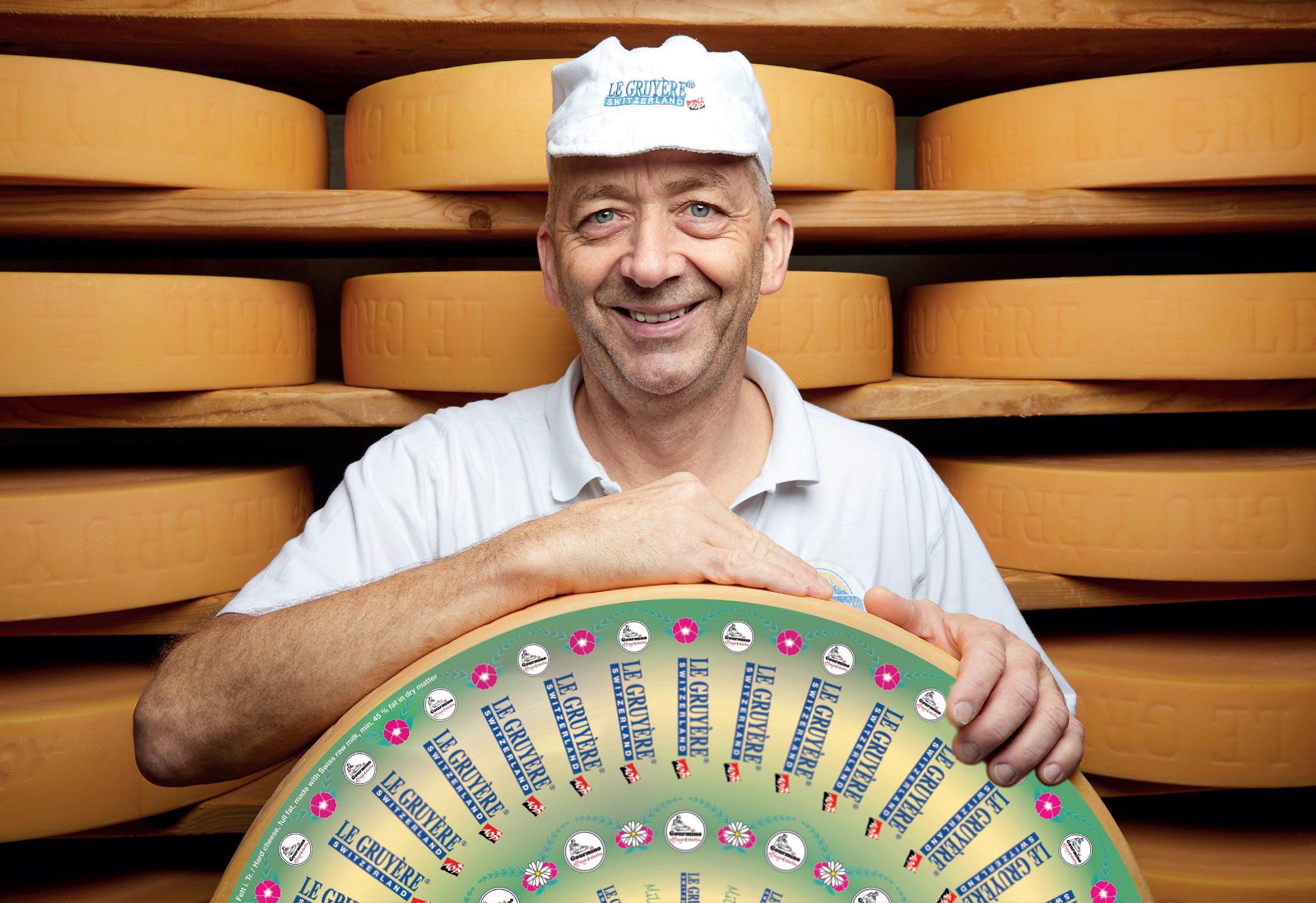
DID YOU KNOW?
Gruyère is named after the town of Gruyères in Fribourg
Switzerland with old friends when the news came through that the cheese had won. “I was there to exchange information about the developments in the industry,” he says. “The pleasant surprise from Wales came just in time for me to underline the success of a consistent quality strategy.”
Gourmino’s “consistent quality strategy” is rooted in the fact that it is owned by cheesemakers, who are committed to traditional, artisan skills and using the best milk. “Our skills lie in the affinage of long-ripened cheeses made from raw milk,” he says. “We use only the best quality cheeses selected from our own dairies. Our dairies are family businesses that use fresh milk supplied daily by local farmers. The cheesemakers not only care passionately about their craft, they also have the necessary experience spanning years of excellent work and life in cheese. Only cheese of perfect quality can be aged for longer periods of time. That is why we pay more for higher quality and less for average quality compared to the standard in this
A series of underground bunkers turned into cheese caves are part of the reason why a Gruyère made in a Swiss mountain dairy and matured by affineur Gourmino triumphed at the 2022 World Cheese Awards
10
LE GRUYÈRE: PRIDE OF PLACE
sector. Cheese affinage is our specialty.”
Urs Leuenberger’s Gruyere is a perfect example of the strategy. Gourmino has worked with Vorderfultigen for many years, maturing the cheeses mostly as Surchoix (high quality, long aged) or Reserve (over 10 months).
“The quality of Urs Leuenberger’s cheese is particularly suitable for the long affinage of 12 to 18 months,” says Sahli. “For years, the characteristic of the cheeses has always been a fine, supple texture, which melts on the tongue with age. The flavour profile ranges from fruity at mild maturity to slightly salty at around 15 months of age. But the cheese is always harmoniously balanced.”
Vorderfultigen and Gourmino’s Gruyère beat 4,434 other entries at the World Cheese Awards to claim the top title last year in Newport. Swiss judge Christian Zuercher, who championed the cheese, praised it for being “smooth in your mouth and melting on your tongue.

You have a lot of flavour in it, from herbs to fruity, roasted, with a real leather note”.
Dennis Kaser, international marketing manager at Le Gruyère AOP, said the win demonstrated the power of the collective. “This is a result that shows the quality behind all these people working together; 1900 milk producers, 155 cheesemakers and 11 refiners. This collaborative work results in such a high quality cheese style, which is loved by the consumer.”
It capped a great year for Gourmino, after another of its Gruyère, made by Mountain Dairy Fritzenhaus in Bern, took the top prize at the World Championship Cheese Contest in Wisconsin in March.
“This means that Gourmino has won with two different cheesemakers at the two most important international quality competitions – comparable to the Grand Slam in tennis,” says Sahli. “An exceptional achievement, unprecedented in the 50-year history of
LE GRUYÈRE SWEEPS THE BOARD AT THE WORLD CHEESE AWARDS 2022
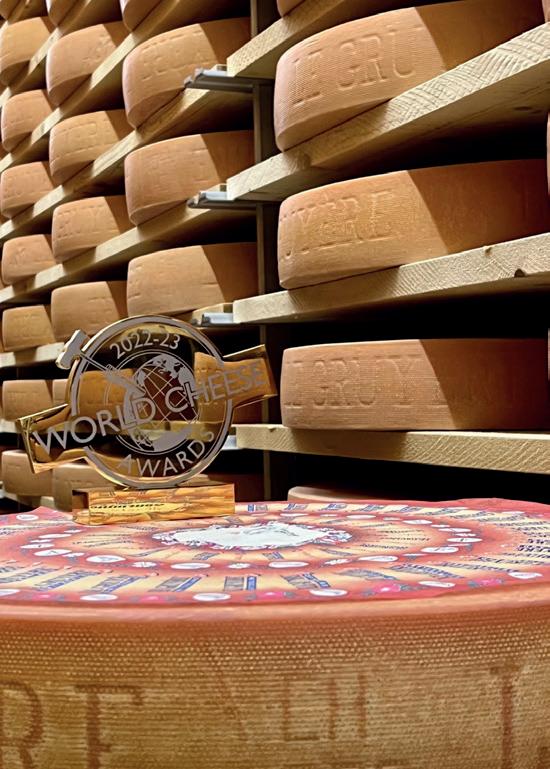
Vorderfultigen and Gourmino’s win at the World Cheese Awards is the fifth time that Le Gruyère AOP has been named Supreme Champion – more than any other cheese in the awards’ history.
But there were plenty of other awards for Le Gruyère AOP cheesemakers with 68 medals awarded to the cheese in total. These included:
20 Bronzes
23 Silvers
19 Golds
6 Super Golds
The six Super Gold cheeses, which included the Supreme Champion, were:
• Alpage Vounetz, Gruyère d’Alpage AOP, Caves de la Tzintre

• Le Gruyère AOP Premier Cru, Cremo
• Orsonnens Gruyère AOP, 12 months affinage, Corsé Moléson
• Vorderfultigen Le Gruyère AOP Surchoix, Gourmino
• Le Gruyère AOP Premier Cru, Cremo
• Gruyère Switzerland AOP Extra, Walo von Mühlenen

the two contests.”
Since winning at the World Cheese Awards, Gourmino has seen huge interest from the media and increased demand from the UK, US, Scandinavia, Spain and France in particular.
Sahli says the win has reinforced the company’s strategy of focusing on “qualitative differentiation” as well as storytelling for the individual cheesemaker in specialist cheese shops. “We currently have three cheese dairies with three experienced master cheesemakers, which we have positioned in the speciality market for cheese counters with different flavour and texture profiles,” he says. “Le Gruyère AOP is a traditional product with history and an important economic significance for a whole region. For me personally, a Gruyère aged for 15 months is a raw milk cheese close to perfection because of its balanced but strong flavour combined with a fine but already slightly crumbly consistency.”
LE GRUYÈRE: PRIDE OF PLACE 11
AN ANCIENT RECIPE WITHOUT GLUTEN OR LACTOSE. TALK ABOUT FORWARD THINKING.












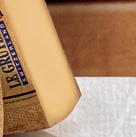
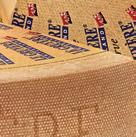




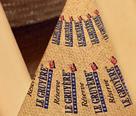

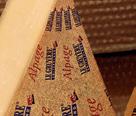


















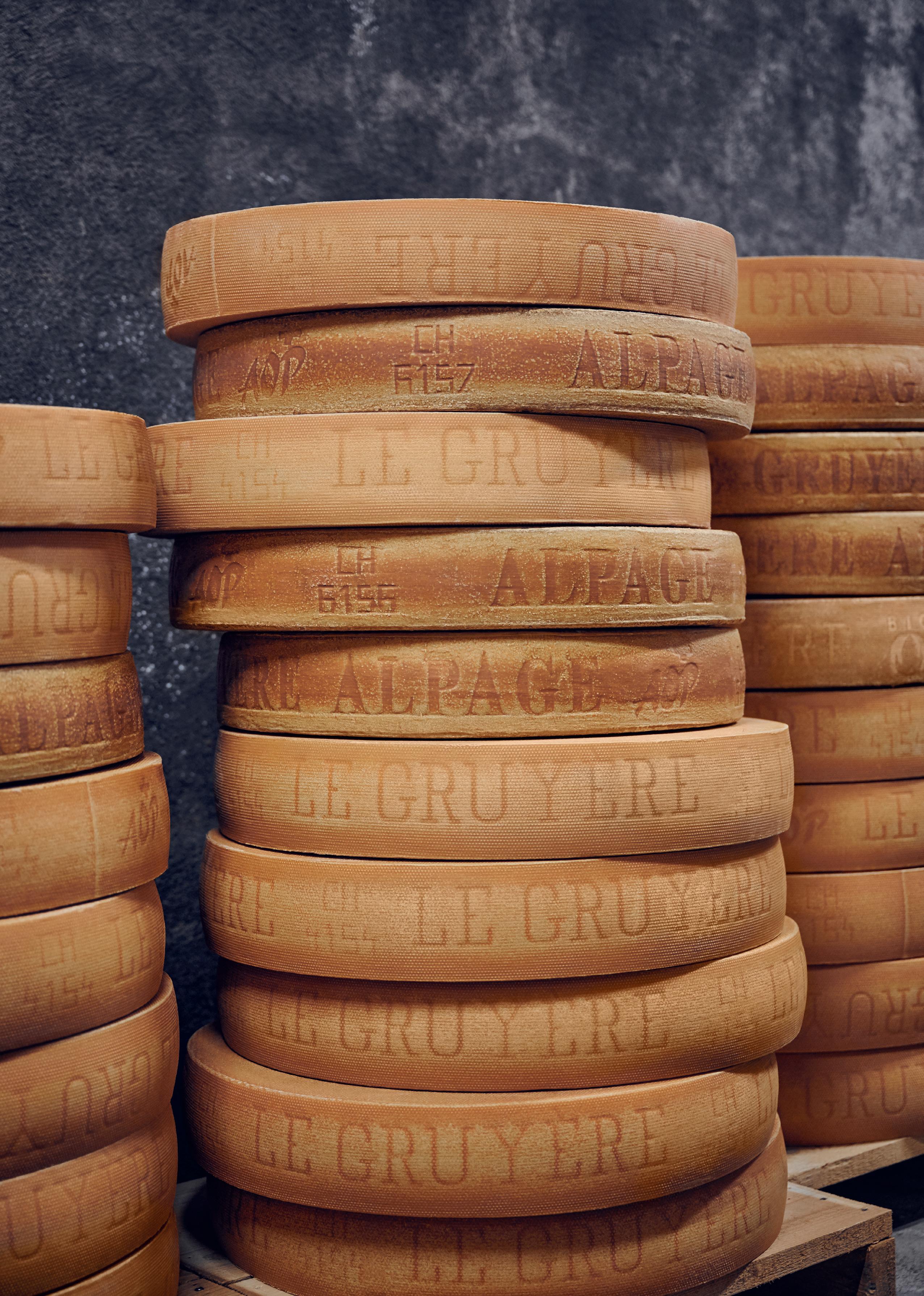
PRIDE OF
12
LE GRUYÈRE:
PLACE





























































